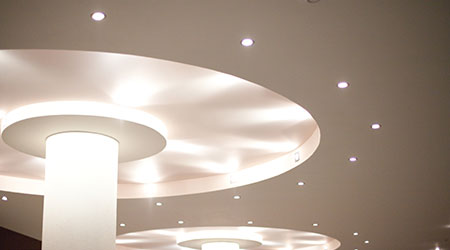 Managers must make the decision to upgrade existing lighting only after careful evaluation.
Managers must make the decision to upgrade existing lighting only after careful evaluation. LED Upgrades: Considerations and Challenges
The fundamental components managers need to consider when upgrading a facility’s lighting include lumen output and ballast compatibility, along with controls and dimming needs.
The fundamental components managers need to consider when upgrading a facility’s lighting include lumen output and ballast compatibility, along with controls and dimming needs.
While not always recommended, the simplest upgrade for many facilities is a one-for-one replacement of existing fluorescent lamps with new LED replacement tubes. Considering lumen output is essential when choosing the most appropriate replacement lamps, especially when working with existing, non-dimming fixtures. A lumen is the standard unit of measurement for luminous flux, the measure of the perceived power of light. LED sources rank above fluorescent lamps in their system efficiency, or the amount of light that actually reaches a targeted area after all losses are accounted for.
In terms of directionality, fluorescent lights are omnidirectional sources that emit light in a 360 degree pattern, meaning the entire circumference of the tube emits light. On the other hand, LED light sources rely on individual diodes to produce light, which means that LED retrofit tubes generally will only emit light in a 180 degree arc originating from the strip of diodes.
In LED tubes, the diodes always point down from the fixture towards the space. This orientation effectively provides more useful lumens and overall system efficiency because the entirety of the light being is directed downward and is not wasted through reflections within the fixture. But it can create a disconnect between the effective lumen output of a fluorescent lamp when compared to an LED replacement lamp.
Consider this example: One facility manager replaced all fluorescent tubes in one department with new LED replacement tubes. But end users considered the resulting lighting level to be too high. As a result, new replacement lamps had to provide a lower lumen output.
To avoid this scenario, managers can use a range of tools to help facilities choose the right replacement source. Many of these tools rely on knowledge of the desired illumination level in lux or footcandles. If managers do not have this information, one easy but not always perfect solution is to have the operator match the lumen output of the existing lamps being replaced.
Carefully measuring the desired lumen output of the replacement lamp also can impact the true energy savings. If managers select an incorrect replacement that emits more lumens than needed, the overall energy savings will be lower.
Managers who are considering the use of replacement LED tubes should understand ballast compatibility. The chances that an existing ballast is compatible with a replacement LED tube is a potential concern, but the number of replacement tubes on the market that are compatible with existing ballasts is rising.
Related Topics:














